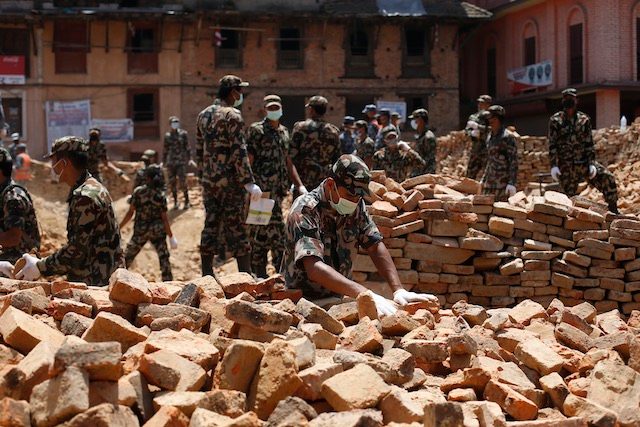SUMMARY
This is AI generated summarization, which may have errors. For context, always refer to the full article.

KATHMANDU, Nepal – Ministries in Nepal battled Thursday, May 14, to get aid to some of the remotest terrain on Earth, working from tents and makeshift shelters after an earthquake severely damaged government buildings in the capital.
Tuesday’s (May 12) deadly 7.3-magnitude quake triggered landslides and brought down buildings weakened by an even larger tremor on April 25 that killed more than 8,000 people and destroyed nearly half a million homes.
Nepal’s government, which admits to being overwhelmed by the scale of the April 25 disaster, is now racing to deliver relief to remote mountainous areas in the east of the country worst hit by the latest quake.
The difficulties have been compounded by extensive damage to the Singha Durbar government complex in Kathmandu, parts of which are now so unstable they can no longer be used.
The prime minister’s spokesman Uttar Kumar Khatri said even his team was now operating out of a tent, calling it a “difficult situation”.
“Our operations right now are all focused on disaster management,” he told Agence France-Presse.
“We are now trying to see where everyone can be accommodated in buildings that are safe.”
In Kathmandu, where 11 people died on Tuesday, many traumatized survivors spent another night outdoors, afraid to return to their houses.
Search for missing chopper
Meanwhile, a major search operation resumed Thursday for a US military helicopter that disappeared with 8 people on board while delivering aid to earthquake victims.
For a third straight day, US and Nepalese military helicopters and hundreds of ground troops scoured a remote mountainous area where the chopper went missing, underscoring the huge challenge of operating in the Himalayan country.
“We began searching early today with two army helicopters. About 400 troops have been deployed for this,” Rajan Dahal of the Nepal Army told Agence France-Presse by phone from eastern Dolakha district where the chopper disappeared.
With many of the worst-hit areas inaccessible by road, more than 1,400 people have been airlifted from quake-hit areas, most of them by Nepalese troops.
Home ministry spokesman Laxmi Prasad Dhakal said the death toll from Tuesday’s quake, which was centered 76 km (47 miles) east of Kathmandu, had risen to 96 overnight with more than 2,500 wounded.
Many of the victims were in Dolakha and in neighboring Sindhupalchowk, and the quake also killed 17 people in northern India and one in Tibet.
The tremor added to the huge challenge of getting relief to victims of the 7.8-magnitude quake of April 25, the biggest to hit Nepal in 80 years, with landslides reported to be blocking several roads.
The United Nations said there was an “urgent need for tents, generators and fuel supply to ensure that radio stations continue broadcasting and collecting information from affected communities”.
Scientists said Tuesday’s quake was part of a chain reaction set off by the April one that struck in Lamjung district west of Kathmandu.
“Large earthquakes are often followed by other quakes, sometimes as large as the initial one,” said Carmen Solana, a volcanologist at Britain’s University of Portsmouth.
“This is because the movement produced by the first quake adds extra stress on other faults and destabilizes them,” she told the London-based Science Media Centre. – Paavan Mathema, AFP / Rappler.com
Add a comment
How does this make you feel?
There are no comments yet. Add your comment to start the conversation.